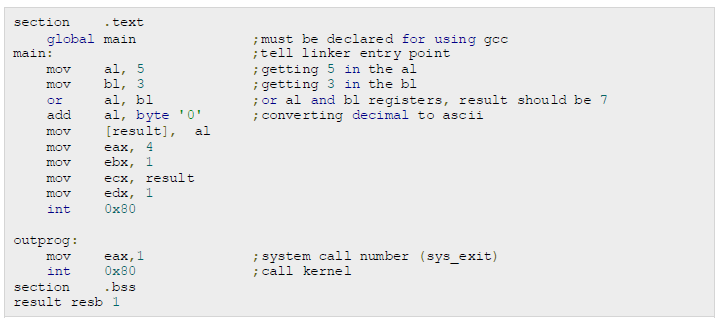
Logical Instructions
The processor instruction set provides the instructions AND, OR, XOR, TEST and NOT Boolean logic, which tests, sets and clears the bits according to the need of the program.
The format for these instructions:

The first operand in all the cases could be either in register or in memory. The second operand could be either in register/memory or an immediate (constant) value. However, memory to memory operations are not possible.
These instructions compare or match bits of the operands and set the CF, OF, PF, SF and ZF flags.
The AND Instruction
The AND instruction is used for supporting logical expressions by performing bitwise AND operation. The bitwise AND operation returns 1, if the matching bits from both the operands are 1, otherwise it returns 0. For example: 
The AND operation can be used for clearing one or more bits. For example, say, the BL register contains 0011 1010. If you need to clear the high order bits to zero, you AND it with 0FH.

Let's take up another example. If you want to check whether a given number is odd or even, a simple test would be to check the least significant bit of the number. If this is 1, the number is odd, else the number is even.
Assuming the number is in AL register, we can write:

The following program illustrates this:
Example:

When the above code is compiled and executed, it produces fol owing result:

Change the value in the ax register with an odd digit, like:

The program would display:

Similarly to clear the entire register you can AND it with 00H.
The OR Instruction
The OR instruction is used for supporting logical expression by performing bitwise OR operation. The bitwise OR operator returns 1, if the matching bits from either or both operands are one. It returns 0, if both the bits are zero.
For example,


The OR operation can be used for setting one or more bits. For example, let us assume the AL register contains 0011 1010, you need to set the four low order bits, you can OR it with a value 0000 1111, i.e., FH.

Example:
The follow ing example demonstrates the OR instruction. Let us stor e the value 5 and 3 in the AL and the BL register respectively. Then the instruction,

should store 7 in the AL register:

When the above code is compiled and executed, it produces following result:

The XOR Instruction
The XOR instruction implements the bitwise XOR operation. The XOR operation sets the resultant bit to 1, i f and only if the bits from the operands are different. If the bits from the operands are same (both 0 or both 1), the resultant bit is cleared to 0.
For example,

The TEST Instruction
The TEST instruction works same as the AND operation, but unlike AND instruction, it does not change the first operand. So, if we need to check whether a number in a register is even or odd, we can also do this using the TEST instruction without changing the original number.

The NOT Instruction
The NOT instruction implements the bitwise NOT operation. NOT operation reverses the bits in an operand. The operand could be either in a register or in the memory.
For example,













